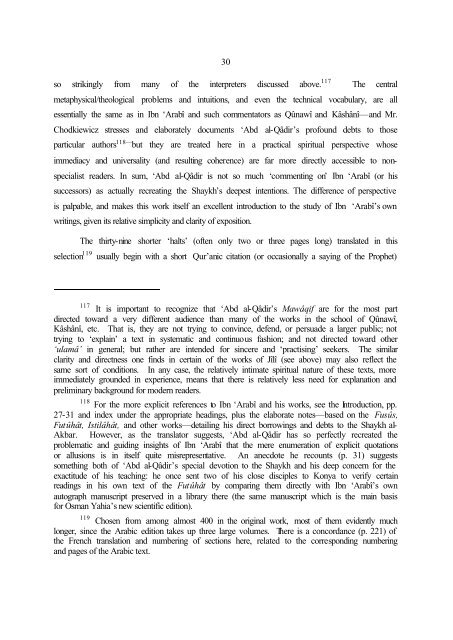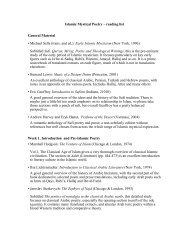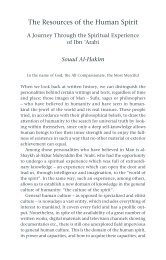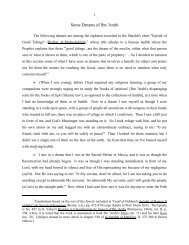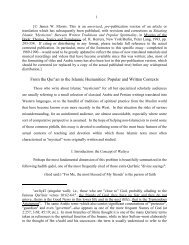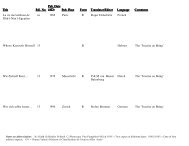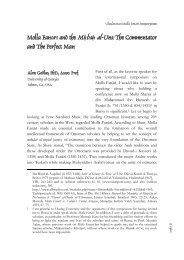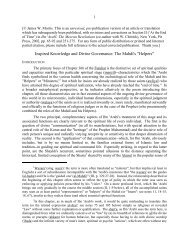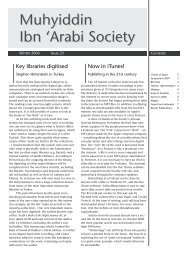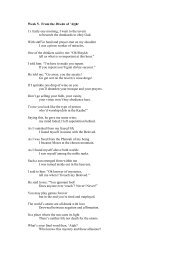Part III (pdf) - Muhyiddin Ibn Arabi Society
Part III (pdf) - Muhyiddin Ibn Arabi Society
Part III (pdf) - Muhyiddin Ibn Arabi Society
Create successful ePaper yourself
Turn your PDF publications into a flip-book with our unique Google optimized e-Paper software.
30so strikingly from many of the interpreters discussed above. 117 The centralmetaphysical/theological problems and intuitions, and even the technical vocabulary, are allessentially the same as in <strong>Ibn</strong> ‘Arabî and such commentators as Qûnawî and Kâshânî—and Mr.Chodkiewicz stresses and elaborately documents ‘Abd al-Qâdir’s profound debts to thoseparticular authors 118— but they are treated here in a practical spiritual perspective whoseimmediacy and universality (and resulting coherence) are far more directly accessible to nonspecialistreaders. In sum, ‘Abd al-Qâdir is not so much ‘commenting on’ <strong>Ibn</strong> ‘Arabî (or hissuccessors) as actually recreating the Shaykh’s deepest intentions. The difference of perspectiveis palpable, and makes this work itself an excellent introduction to the study of <strong>Ibn</strong> ‘Arabî’s ownwritings, given its relative simplicity and clarity of exposition.The thirty-nine shorter ‘halts’ (often only two or three pages long) translated in thisselection 119 usually begin with a short Qur’anic citation (or occasionally a saying of the Prophet)117 It is important to recognize that ‘Abd al-Qâdir’s Mawâqif are for the most partdirected toward a very different audience than many of the works in the school of Qûnawî,Kâshânî, etc. That is, they are not trying to convince, defend, or persuade a larger public; nottrying to ‘explain’ a text in systematic and continuous fashion; and not directed toward other‘ulamâ’ in general; but rather are intended for sincere and ‘practising’ seekers. The similarclarity and directness one finds in certain of the works of Jîlî (see above) may also reflect thesame sort of conditions. In any case, the relatively intimate spiritual nature of these texts, moreimmediately grounded in experience, means that there is relatively less need for explanation andpreliminary background for modern readers.118 For the more explicit references to <strong>Ibn</strong> ‘Arabî and his works, see the Introduction, pp.27-31 and index under the appropriate headings, plus the elaborate notes—based on the Fusûs,Futûhât, Istilâhât, and other works—detailing his direct borrowings and debts to the Shaykh al-Akbar. However, as the translator suggests, ‘Abd al-Qâdir has so perfectly recreated theproblematic and guiding insights of <strong>Ibn</strong> ‘Arabî that the mere enumeration of explicit quotationsor allusions is in itself quite misrepresentative. An anecdote he recounts (p. 31) suggestssomething both of ‘Abd al-Qâdir’s special devotion to the Shaykh and his deep concern for theexactitude of his teaching: he once sent two of his close disciples to Konya to verify certainreadings in his own text of the Futûhât by comparing them directly with <strong>Ibn</strong> ‘Arabî’s ownautograph manuscript preserved in a library there (the same manuscript which is the main basisfor Osman Yahia’s new scientific edition).119 Chosen from among almost 400 in the original work, most of them evidently muchlonger, since the <strong>Arabi</strong>c edition takes up three large volumes. There is a concordance (p. 221) ofthe French translation and numbering of sections here, related to the corresponding numberingand pages of the <strong>Arabi</strong>c text.


